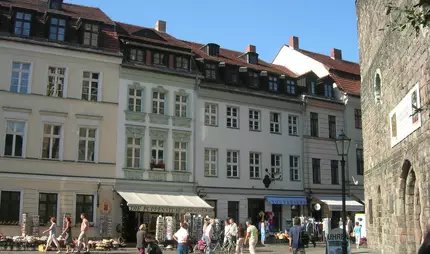
German Revolutionary Period (1830s - 1870s) and German Empire (1871 - 1918)
Industrial Revolution
The numerous fires of the manufacturing furnaces as well as the abundant amounts of smoke emanating from the chimneys of the iron foundries and engineering factories situated in the suburb of Oranienburg gave the name of “land of fire” to parts of the suburb. August Borsig built the first locomotive independently developed in Germany here, and Emil Rathenau, founder of AEG, started the triumphal procession of electric light in Berlin with Edison’s light bulbs. Companies such as Siemens (1847), Schering (1864) and Schwartzkopff (1852), which are today household names, sprang up and attracted an ever increasing number of workers from the countryside to the city. The population of Berlin, including adjacent housing estates rose to 400,000 inhabitants.
Bourgeois Democratic Revolution
The industrial revolution was also associated with the decline of trades and handicrafts and the simultaneous creation of an industrial proletariat in Berlin. The wretched working conditions, unemployment, misery, failed harvests and increasing food prices led to repeated uprisings. The first small-scale uprisings (by tailors in 1830, pyrotechnicians in 1835 and the potato revolts of 1847) were rigidly stamped on by the authorities and culminated in the German Revolution (also known as the March Revolution) in 1848 - 1849. In view of the bourgeois democratic and national uprisings in the name of unity and independence, as well as the barricade fighting in Berlin, a badly shaken King Frederick Wilhelm IV felt obliged to initially make political concessions in March 1848. Following the “Zeughaussturm“ (Berlin Arsenal riots) in June 1846, these were withdrawn in the course of the counter-revolution, and the old balance of power was restored with the dissolution of the Prussian National Assembly. In 1869 the Berlin Magistrate (municipal authorities) moved into its new “Red Town Hall”. In 1998 on the 150th anniversary of the March Revolution, commemorative plaques were set up as memorials of the barricade fighting and the ensuing victims (at the corner of Oberwallstraße and Werderstraße, in Taubenstraße / Friedrichstraße, at the German Cathedral on Gendarmenmarkt – amongst many others).
Capital of the German Reich
Following the incorporation of the suburbs of Wedding, Gesundbrunnen and Moabit as well as parts of the Feldmarken (Field Marches) of Charlottenburg, Schöneberg, Tempelhof und Rixdorf, there were almost 1 million people living in Berlin and its suburbs at the beginning of the German Reich (Empire) in 1871. Tenement buildings, typical for Berlin, sprang up, such as the Viktoriastadt district in Lichtenberg and the representative Gründerzeit (Late Wilhelmine Period) villa colonies in Lichterfeld-West. Following Prussia’s victory over France in the 1870/1871 war, Reich Chancellor Otto von Bismarck initially adopted a liberal course towards leftist groupings such as August Bebel and Wilhelm Liebknecht’s Socialist Workers Party. Only to clamp down hard on them in 1878 with the “law against the strivings of social democracy that constitute a public danger”. The first Reichstag elections under Kaiser Wilhelm II resulted in the SAPD becoming the strongest party, and Bismarck was dismissed from office. In 1906, the shoemaker Wilhelm Voigt took advantage of the blind obedience to a uniform so fixed in Prussian mentality – dressed as an Army Captain, he ordered genuine soldiers to accompany him to the Köpenick Town Hall where he stole money from the treasury and resident permits. He thus went into history as the “Captain of Köpenick”. In 1907, KaDeWe (Kaufhaus des Westens), an enormous department store, opened on Wittenbergplatz, making its business with high-end, luxury products.
Greater Berlin
The year 1911 saw, as a result of the ”Zweckverbandsgesetz (Administrative Union Law) for Greater Berlin”, the merging together of the kreisfrei (separate administrative) cities of Berlin, Charlottenburg, Deutsch-Wilmersdorf, Lichtenberg, Neukölln, Schöneberg and Spandau as well as the Landkreise (administrative districts) of Niederbarnim and Teltow. The administrative union of Berlin, now comprising an area of some 3,500 square kilometres (1,350 miles²) and 4.2 million inhabitants, did not result in the hoped-for social redistribution among the individual boroughs. It was only in the period of the Weimar Republic, following the so-called Greater Berlin Law of 1920, that Berlin was able to become an independent administrative district enjoying functions similar to a province and thus emerge as the second largest city in the world (in terms of land area) – by the process of incorporating Berlin-Lichtenberg, Berlin-Schöneberg, Berlin-Wilmersdorf, Charlottenburg, Neukölln and Spandau as well as the Stadtgemeinde (municipality) of Cöpenick, 59 Landgemeinde (rural communities) and 27 Gutsbezirke (agricultural estates) from the districts of Niederbarnim, Osthavelland and Teltow.



